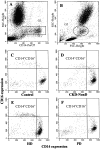Effect of different dialysis modalities on microinflammatory status and endothelial damage
- PMID: 20056757
- PMCID: PMC2827586
- DOI: 10.2215/CJN.03260509
Effect of different dialysis modalities on microinflammatory status and endothelial damage
Abstract
Background and objectives: We studied the relationship between microinflammation and endothelial damage in chronic kidney disease (CKD) patients on different dialysis modalities.
Design, setting, participants, & measurements: Four groups of CKD stage 5 patients were studied: 1) 14 nondialysis CKD patients (CKD-NonD); 2) 15 hemodialysis patients (HD); 3) 12 peritoneal dialysis patients with residual renal function >1 ml/min (PD-RRF >1); and 4) 13 peritoneal dialysis patients with residual renal function <or=1 ml/min (PD-RRF <or=1). Ten healthy subjects served as controls. CD14(+)CD16(+) cells and apoptotic endothelial microparticles (EMPs) were measured by flow cytometry. Serum vascular endothelial growth factor (VEGF) was measured by ELISA.
Results: CKD-NonD and HD patients had a higher percentage of CD14(+)CD16(+) monocytes than PD groups and controls. CD14(+)CD16(+) was similar in the PD groups, regardless of their RRF, and controls. The four uremic groups displayed a marked increase in apoptotic EMPs and VEGF compared with controls. Apoptotic EMPs and VEGF were significantly higher in HD patients than in CKD-NonD and both PD groups. However, there were no significant differences between CKD-NonD and the two PD groups. There was a correlation between CD14(+)CD16(+) and endothelial damage in CKD-NonD and HD patients, but not in PD and controls.
Conclusions: There was an increase in CD14(+)CD16(+) only in CKD-NonD and HD patients. In these patients, there was a relationship between increased CD14(+)CD16(+) and endothelial damage. These results strongly suggest that other factors unrelated to the microinflammatory status mediated by CD14(+)CD16(+) are promoting the endothelial damage in PD, regardless of their RRF.
Figures




Similar articles
-
Post-dilution high convective transport improves microinflammation and endothelial dysfunction independently of the technique.Blood Purif. 2013;35(4):270-8. doi: 10.1159/000350611. Epub 2013 May 8. Blood Purif. 2013. PMID: 23689471 Clinical Trial.
-
Strong depletion of CD14(+)CD16(+) monocytes during haemodialysis treatment.Nephrol Dial Transplant. 2001 Jul;16(7):1402-8. doi: 10.1093/ndt/16.7.1402. Nephrol Dial Transplant. 2001. PMID: 11427632
-
Expression of Fc gamma receptor III (CD16) on monocytes during hemodialysis in patients with chronic renal failure.Nephron. 2002 Jan;90(1):64-71. doi: 10.1159/000046316. Nephron. 2002. PMID: 11744807
-
Microinflammation and endothelial damage in hemodialysis.Contrib Nephrol. 2008;161:83-88. doi: 10.1159/000130412. Contrib Nephrol. 2008. PMID: 18451662 Review.
-
CD14+CD16+ monocytes from chronic kidney disease patients exhibit increased adhesion ability to endothelial cells.Contrib Nephrol. 2011;171:57-61. doi: 10.1159/000327134. Epub 2011 May 23. Contrib Nephrol. 2011. PMID: 21625090 Review.
Cited by
-
Transcriptome analysis in patients with chronic kidney disease on hemodialysis disclosing a key role for CD16+CX3CR1+ monocytes.PLoS One. 2015 Apr 1;10(4):e0121750. doi: 10.1371/journal.pone.0121750. eCollection 2015. PLoS One. 2015. PMID: 25830914 Free PMC article.
-
New Insights into the Roles of Monocytes/Macrophages in Cardiovascular Calcification Associated with Chronic Kidney Disease.Toxins (Basel). 2019 Sep 12;11(9):529. doi: 10.3390/toxins11090529. Toxins (Basel). 2019. PMID: 31547340 Free PMC article. Review.
-
Extracellular vesicles: biomarkers and regulators of vascular function during extracorporeal circulation.Oncotarget. 2018 Dec 14;9(98):37229-37251. doi: 10.18632/oncotarget.26433. eCollection 2018 Dec 14. Oncotarget. 2018. PMID: 30647856 Free PMC article. Review.
-
Low serum vitamin D concentration is correlated with anemia, microinflammation, and oxidative stress in patients with peritoneal dialysis.J Transl Med. 2021 Sep 27;19(1):411. doi: 10.1186/s12967-021-03077-w. J Transl Med. 2021. PMID: 34579742 Free PMC article.
-
Increase in Peripheral Blood Intermediate Monocytes is Associated with the Development of Recent-Onset Type 1 Diabetes Mellitus in Children.Int J Biol Sci. 2017 Feb 5;13(2):209-218. doi: 10.7150/ijbs.15659. eCollection 2017. Int J Biol Sci. 2017. PMID: 28255273 Free PMC article.
References
-
- Foley RN, Parfrey PS, Sarnak MJ: Epidemiology of cardiovascular disease in chronic renal disease. J Am Soc Nephrol 9: S16–23, 1998 - PubMed
-
- Ma KW, Greene EL, Raij L: Cardiovascular risk factors in chronic renal failure and hemodialysis populations. Am J Kidney Dis 19: 505–513, 1992 - PubMed
-
- Lameire N, Bernaert P, Lambert MC, Vijt D: Cardiovascular risk factors and their management in patients on continuous ambulatory peritoneal dialysis. Kidney Int Suppl 48: S31–S38, 1994 - PubMed
-
- Den Elzen WP, van Manen JG, Boeschoten EW, Krediet RT, Dekker FW: The effect of single and repeatedly high concentrations of C-reactive protein on cardiovascular and non-cardiovascular mortality in patients starting with dialysis. Nephrol Dial Transplant 21: 1588–1595, 2006 - PubMed
-
- Papagianni A, Kokolina E, Kalovoulos M, Vainas A, Dimitriadis C, Memmos D: Carotid atherosclerosis is associated with inflammation, malnutrition and intercellular adhesion molecule-1 in patients on continuous ambulatory peritoneal dialysis. Nephrol Dial Transplant 19: 1258–1263, 2004 - PubMed
Publication types
MeSH terms
Substances
LinkOut - more resources
Full Text Sources
Medical
Research Materials

